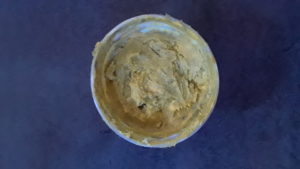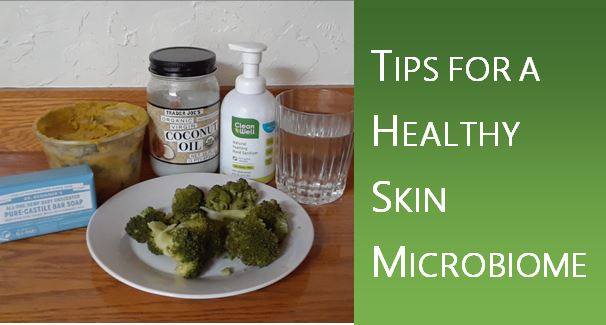“The skin microbiome plays an important role in developing and maintaining homeostasis and regulation of the host immune system [3].” Are the billions of viruses, bacteria, fungi, and mites living on our skin the right ones? Are they ones that promote health or destroy health? Does the skin itch and break out, or does it feel strong and healthy?
After many years of trial and error, here are our family’s tips for maintaining a healthy skin microbiome. Here is the outline of what we’ve learned:
Water, Diet & Stress
Water, Diet & Stress
Drinking water, eating a healthy diet, and reducing stress are key to maintaining a healthy skin microbiome.
Children in our house drink 1.5 Liters (L) minimum per day. Adults drink 3 L minimum. Currently the medical community says one should consume about 2 L, or eight 8-ounce glasses, of water per day.
My opinion about the best diet for healthy skin is the same as my recommendations for the best diet for health. The thing I would stress specifically for healthy skin is aiming for a 1:1 ratio of Omega 3: Omega 6 fats.
Stress can also shift the organism balance in our gut and skin. Ideas for reducing stress might be breathing, yoga, meditation, or learning to say “No.”
Soap
Some of the soaps on the market have chemicals or other ingredients that kill microorganisms on the skin. Dr. Bronners unscented soap is the best we’ve found for maintaining a healthy skin microbiome.
Skin Lotion
The lotion we put on our skin doesn’t have chemicals, preservatives, or ingredients with which we aren’t familiar.
The skin lotion we use is a homemade mix of Raw Shea butter with Prescript Assist probiotic in. It doesn’t look very good, but we’ve found it works well to help maintain a healthy skin microbiome.

When applied to the skin, it has small black specs in it from the probiotic. I find that they magically disappear after an hour or so. And yes, we do put it on our face.
In addition to lotion, our family has also been known to rub Fulvic Humic mineral blend on our legs and arms. We started doing this to address mineral deficiencies, but I later realized that it seems to help maintain a healthy skin microbiome too!
Heal Leaky Gut
Studies are starting to shed light on the connection between the health of the gut and the health of the skin microbiome [1]. Our tips for healing leaky gut have already been revealed under the “Gut” tab.
Sweat
Sweat helps with acidification of the skin, which helps maintain a healthy balance of microorganisms [2]. One may be worried about smell, but we’ve found that coupled with a healthy diet, smell isn’t usually an issue.
Daily, small amounts of sweat are most helpful, because one is less likely to shower afterwards. Things like taking the stairs and going for a brisk walk over lunch help maintain the skin microbiome!
Don’t Shower Everyday
Part of the benefit of sweating is lost if we scrub it off everyday. On the flip side, one wants to maintain a clean appearance. Too much dirt buildup can cause itching and infection.
Where is the balance point? After big-sweat events like sauna or a soccer game, we shower. After smaller-sweat events like a brisk walk or playing outside, we won’t shower. My personal opinion is that showering 3 times a week seems to work well from a microbiome perspective.
Sunshine
UV radiation from the sun changes the microbial landscape of the skin [3]. We have the experience that air-drying our armpits in the sunlight can reduce odor significantly. I always thought this was due to a decrease in moisture, but it may also be due to the UV radiation shifting the microorganism balance. I digress…
On the flip side, sunshine in very high doses can lead to skin disease.
Where is the balance for sunshine? We enjoy sunlight in moderation in our family.
Shampoo and Conditioner
For many years, we used aluminum-free baking soda for shampoo and coconut oil for conditioner. I think this is a great idea. These days, the kids want to smell like their friends and don’t want a ‘wet look’ to their hair. So, we have migrated to using Shea Moisture Shampoo and Conditioner. Note that some of this brand’s shampoos and conditioners contain ingredients that we do not endorse. The two linked above seem to be fine, at least for now. (Remember, we do not monetize any links or receive any money for endorsements)
Hand Sanitizer
Hand sanitizer is designed to kill the organisms on the skin. This is great if one is trying to eat a meal with the hands, for example. It’s not so great for the skin microbiome, however.
Our family tries try to stay away from hand sanitizer. We prefer to use unscented soap. If we are in a situation where we do need to use hand sanitizer, we use Clean Well.
Why Clean Well? First, it has all ingredients that we know and can pronounce. Secondly, we don’t see any ingredients that are not easily washed off later with soap. Thirdly, we have been using it for many years and have yet to have any side effects.
Getting Dirty (or not!)
A popular recommendation at the time of writing is to play in the dirt to improve the skin microbiome. The recommendation is often made for young children. This is a conundrum.
In many public places, like parks and schools, the soil is contaminated. The microbial balance is disturbed by fertilizers, pesticides and chemicals. Parasite eggs from dog, cat and rodent feces are everywhere. We do not encourage our kids to play in the dirt in public parks or schools.
If one has a ‘clean’ source of dirt, then sure, getting dirty might be OK. What is a ‘clean’ source of dirt? Perhaps land that is organically managed, or out in a forest somewhere.
References
[1] V. Ghevariya et al. “The Skin: A Mirror to the Gut,” Int J Colorectal Dis. 2013.
[2] E. Grice, “The Skin Microbiome,” Nat Rev Microbiol, 2011.
[3] V. Patra, “The Skin Microbiome: Is it Affected by UV-induced Immune Suppression?” Frontiers in Microbiology, August 2016.
FAQ
No questions yet, ask away!
Was this information useful? If so, please consider donating to keep this site alive.
Last Updated:


